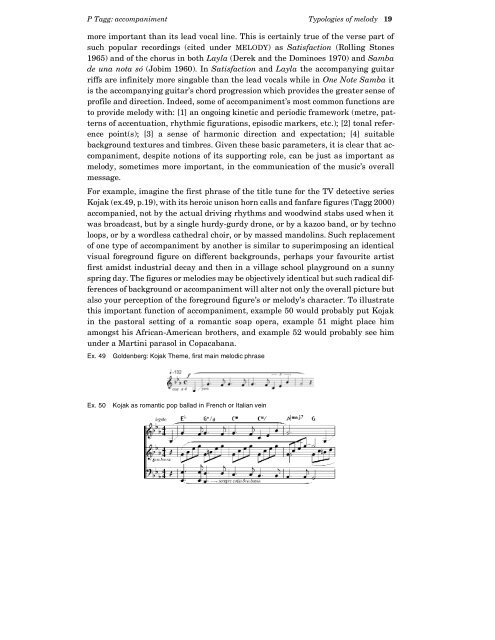Melody and Accompaniment - Philip Tagg
Melody and Accompaniment - Philip Tagg
Melody and Accompaniment - Philip Tagg
Create successful ePaper yourself
Turn your PDF publications into a flip-book with our unique Google optimized e-Paper software.
P <strong>Tagg</strong>: accompaniment Typologies of melody 19<br />
more important than its lead vocal line. This is certainly true of the verse part of<br />
such popular recordings (cited under MELODY) as Satisfaction (Rolling Stones<br />
1965) <strong>and</strong> of the chorus in both Layla (Derek <strong>and</strong> the Dominoes 1970) <strong>and</strong> Samba<br />
de una nota só (Jobim 1960). In Satisfaction <strong>and</strong> Layla the accompanying guitar<br />
riffs are infinitely more singable than the lead vocals while in One Note Samba it<br />
is the accompanying guitar’s chord progression which provides the greater sense of<br />
profile <strong>and</strong> direction. Indeed, some of accompaniment’s most common functions are<br />
to provide melody with: [1] an ongoing kinetic <strong>and</strong> periodic framework (metre, patterns<br />
of accentuation, rhythmic figurations, episodic markers, etc.); [2] tonal reference<br />
point(s); [3] a sense of harmonic direction <strong>and</strong> expectation; [4] suitable<br />
background textures <strong>and</strong> timbres. Given these basic parameters, it is clear that accompaniment,<br />
despite notions of its supporting role, can be just as important as<br />
melody, sometimes more important, in the communication of the music’s overall<br />
message.<br />
For example, imagine the first phrase of the title tune for the TV detective series<br />
Kojak (ex.49, p.19), with its heroic unison horn calls <strong>and</strong> fanfare figures (<strong>Tagg</strong> 2000)<br />
accompanied, not by the actual driving rhythms <strong>and</strong> woodwind stabs used when it<br />
was broadcast, but by a single hurdy-gurdy drone, or by a kazoo b<strong>and</strong>, or by techno<br />
loops, or by a wordless cathedral choir, or by massed m<strong>and</strong>olins. Such replacement<br />
of one type of accompaniment by another is similar to superimposing an identical<br />
visual foreground figure on different backgrounds, perhaps your favourite artist<br />
first amidst industrial decay <strong>and</strong> then in a village school playground on a sunny<br />
spring day. The figures or melodies may be objectively identical but such radical differences<br />
of background or accompaniment will alter not only the overall picture but<br />
also your perception of the foreground figure’s or melody’s character. To illustrate<br />
this important function of accompaniment, example 50 would probably put Kojak<br />
in the pastoral setting of a romantic soap opera, example 51 might place him<br />
amongst his African-American brothers, <strong>and</strong> example 52 would probably see him<br />
under a Martini parasol in Copacabana.<br />
Ex. 49 Goldenberg: Kojak Theme, first main melodic phrase<br />
Ex. 50 Kojak as romantic pop ballad in French or Italian vein














